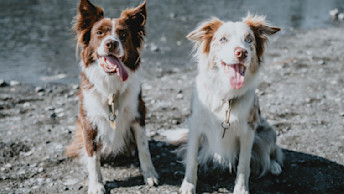March 12, 2024
How to Introduce Dogs to Each Other

When bringing a new dog into a multi-dog household, knowing how to introduce dogs to each other is extremely important. Thoughtfully facilitating introductions allows the dogs to become comfortable with each other, helps to prevent territorial behaviour, and sets the stage for positive interactions.
Prepare Your Home for a New Dog's Arrival
The key to introducing dogs to each other is setting them up for success. Start by preparing your home so each dog has their own dedicated areas and you can control interactions.
Create separate crates or sleeping spaces for each dog. Each dog should have a safe zone that is "theirs." Provide at least one more crate/bed than you have dogs.
Remove any triggers like toys, bones, or high-value treats from shared spaces. You don't want any resource guarding or fights over these items during the delicate intro period.
Consider setting up baby gates with towels draped over them to allow the dogs to get used to each other’s smells before seeing each other and interacting face-to-face. You can also close doors to rooms and rotate the dogs.
Make sure each dog has fresh water, access to toilets, and cozy beds in their dedicated areas. They should feel relaxed and at home.
The goal is to introduce the dogs slowly and minimize conflict triggers in the home environment. With thoughtful preparation, you can set the stage for a safe, gradual introduction process.
Choose the Right Location for the First Introduction
When introducing a new dog to a resident dog, it's important to do the initial meeting outside your home.
Bringing a new dog into your existing dog's territory can create territorial conflicts and stress. Instead, choose a neutral location outside your home for those first interactions, like a nearby park or your driveway.
Before moving directly into a face-to-face introduction, it's beneficial for the dogs to coexist in each other's space without directly focusing on one another. This period allows each dog to grow accustomed to the other's presence without the pressure of interaction, helping to ease any potential tension. This can be achieved by going for a walk together while keeping the dogs from touching or sniffing each other, or conducting a training session where both dogs are occupied with their tasks but still within sight of each other.

When beginning face-to-face introductions, start with both dogs on leashes so you can control them. Keep them at a reasonable distance at first, without letting them get face-to-face right away. Slowly decrease the distance between the two as they appear comfortable.
Having a neutral location removes territorial mindsets, letting the dogs focus simply on getting acquainted in a low-pressure way.
Take it slowly, keeping the dogs leashed, as you allow brief initial greetings and interactions. Once they appear comfortable with each other's presence, you can then move forward to the next steps of introducing them inside the home.
Have Two Handlers Present to Supervise
When introducing dogs to each other for the first time, it's essential to have two handlers present, one for each dog. This allows each handler to control one dog on a leash. Keeping the dogs on leashes prevents them from running up to each other unexpectedly, which could trigger aggression or an overly excited reaction.
Initially, the meeting should be brief, just a few minutes. Don't force the dogs to interact longer than they want to.
End the introduction on a positive note, while the dogs are still calm. You can gradually increase the introduction time with each session as the dogs become more comfortable together.
Introducing a Puppy to an Older Dog
Introducing a new puppy to an older dog has its own unique set of considerations. Puppies, full of energy and yet to learn social manners, may initially overwhelm older dogs. It's essential to allow the older dog to set the pace for interactions.
Ensure the puppy does not invade the older dog's personal space, especially in the beginning.
Puppies are inquisitive and want to explore everything, which might involve stepping into the older dog's territory causing discomfort.
Try to match the energy levels during their interaction. Older dogs may not have the same energy levels as that of a puppy and could get irritated by the constant activity. Guide the puppy to gentler play if it seems too rough or bothersome to the older dog.
In the initial weeks, close supervision is crucial to prevent the formation of negative associations. Remember, older dogs can teach your puppy a lot about proper dog etiquette so use this time as a valuable lesson for your puppy.
Watch Body Language Closely
When introducing dogs, it's crucial to watch their body language closely for signs of stress or discomfort. Look for things like:
Signs of Stress or Discomfort
- Lip licking
- Yawning
- Tense muscles
- Ears back
- Tail down or tucked between the legs
- Avoiding eye contact
- Growling or snarling
These can be signs that a dog is feeling threatened or unsure. If you see them, slow things down and give the dogs more space from each other. On the other hand, relaxed, friendly body language is a good sign. Look for:
Friendly Body Language
- Play bows
- Tail wagging
- Sniffing
- Soft, loose body language
- Relaxed facial expressions
Seeing these behaviours means the dogs are likely feeling comfortable. You can allow them to interact more closely when their body language is loose and friendly. But go slowly and be ready to intervene at the first sign of stress.
Paying close attention to canine body language is key for safe, successful dog-to-dog introductions. Go at the dogs' pace, not your own. And if you're uncertain how to read dog body language, consult with a professional trainer. They can guide you through the introduction process.
Feed Treats to Create Positive Associations
When introducing dogs, using treats to reward and reinforce calm, polite behaviour is one of the most effective techniques. Have plenty of high-value, aromatic treats on hand like small pieces of chicken, cheese, hot dogs, or commercial treats.

Recommended Solution
Healthy Dog Treats with Functional Benefits
Go! Solutions Benefit Chews™ are soft and chewy dog treats that offer functional nutrition in an irresistibly tasty bite!
View treats
Only give treats when the dogs are calm and behaving nicely together. If one dog is fixated on the other, don't reward. Wait for a moment when both dogs are settled and relaxed in each other's presence before tossing treats. Continue treating every few seconds as long as the interaction remains polite. This helps the dogs form positive associations with each other's company.
Be sure both dogs get treats—you want to avoid any resource guarding over the food. Make introductions enjoyable and rewarding for both animals.
Be Positive and Patient
The key to successfully introducing dogs is having an abundance of patience and remaining positive throughout the process. There will likely be some setbacks, conflicts, or tense moments as the dogs get to know each other. It's important not to overreact or punish the dogs if things don't go smoothly at first. Instead, stay calm and use redirection or brief separation if needed.
Tips
Praise and reward any positive interactions with treats or affection. This helps the dogs associate good things with each other's presence.
Keep training sessions brief and end on a high note by allowing the dogs separate time to decompress through toys and play. This also helps them create positive associations.
If there are snarls or scuffles, interrupt the behaviour with a distraction like recall, squeaky toys, or treats (so long as the dogs aren't food aggressive), or learn how to safely separate them using harnesses, collars, or leashes. But don't yell at or punish the dogs.
Separate with baby gates or crates if the dogs need a break from each other for a while. But don't use isolation as punishment.
Keep the dogs separate when they can't be watched. Don't leave the dogs alone unsupervised until you're confident they have positive, friendly interactions.
Stay calm and optimistic. The dogs will pick up on your energy. Getting frustrated will only make the process harder on everyone.
With a steady routine of rewards, training, exercise and quality time, the dogs will likely become friends. But be prepared for this to take days, weeks or even months. Every dog relationship is unique. Focus on small daily progress, and your patience will pay off.



